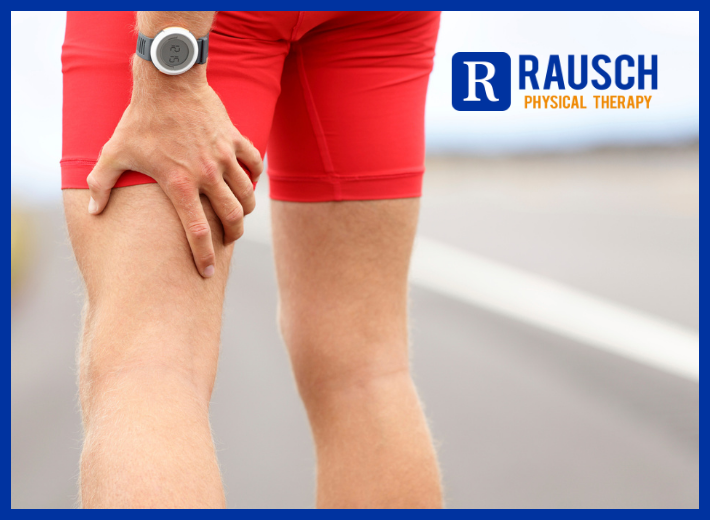Tight hips can subtly impact your daily life and activities, causing discomfort or limiting your movement. Recognizing the signs of restricted hip mobility is key to preventing issues and improving,
Navigating a Hamstring Tear
April 1, 2023 12:18 pm / Category: Rausch Physical Therapy

If you’re experiencing pain or discomfort in your thigh, you may have a hamstring tear. This injury can be painful and can significantly affect your daily activities. Rausch PT understands the importance of proper treatment and rehabilitation to help you recover and regain your strength. Learn the causes, symptoms, and treatment options for hamstring tears below.
A hamstring tear injury is a rip in the hamstring muscles. It happens when the hamstrings are overstretched or overloaded with too much weight. Depending on the injury, the hamstring can tear partially or completely.
The injury can affect one or more of the muscles in your hamstring muscle group. These muscles include the:
- semitendinosus
- semimembranosus
- biceps femoris
These muscles, which are in the back of your thigh, help bend your knees during activities like jumping and running.
While anyone can tear their hamstring, the injury is most common in athletes. Let’s look at the symptoms, treatment, and typical recovery of hamstring tears.
Torn hamstring causes
Typically, a hamstring tear occurs during physical activity. Common causes include:
- Athletic injuries. Most torn hamstrings are caused by extreme stretching or overload during a sport. The injury often happens to people who play sports like soccer, football, and ice hockey.
- Past hamstring injury. If you’ve torn your hamstring in the past, you’re more likely to tear it again. The risk is higher if you do intense activity before you’re fully healed.
- Overtraining. Training too hard can overload your hamstrings and cause tears.
- Poor flexibility. If you have limited flexibility, certain movements may stretch your muscles too far.
In addition to athletes, older people are prone to hamstring tears. That’s because flexibility often declines with age.
Adolescent athletes, who are still growing, are also at risk. Since bone and muscle grow at different rates, the growing bone can tighten the hamstring muscles, making them more susceptible to injury.
Torn hamstring symptoms
The symptoms of a torn hamstring depend on the severity of your injury. You might feel:
- sudden, sharp pain
- a “popping” sensation at the time of injury
- tenderness
- swelling within the first few hours
- bruising within the first few days
- partial or complete weakness in your leg
- inability to place weight on your leg
Hamstring tear grades
Depending on their severity, hamstring injuries are categorized into one of three grades.
Grade 1 is mild hamstring strain, which is also called a pulled hamstring. It happens when the hamstring muscles overstretch but don’t tear.
If the hamstring stretches to the point where it rips, the injury is considered a tear. Hamstring tear grades include:
Grade 2 hamstring tear
A grade 2 hamstring tear is a partial muscle tear. This means the muscle hasn’t fully ripped.
Compared to a grade 1 strain, a grade 2 tear is more painful. Your leg will feel somewhat weak and you’ll likely limp.
Grade 3 hamstring tear
The most severe hamstring tear is a grade 3 hamstring tear. It occurs when the hamstring muscle rips completely or tears off the bone. A tear that pulls the muscle off the bone is called an avulsion.
If you have a grade 3 tear, you likely heard a “popping” sound or sensation when you got the injury. The back of your thigh will also be extremely painful and swollen.
Because this tear is so severe, you may not be able to put weight on the injured leg.
Hamstring tear vs. strain
While some people use “tears” and “strains” interchangeably, the terms don’t necessarily mean the same thing.
In a hamstring tear, the muscle fibers stretch so much that they rip. A strain, on the other hand, is when the muscle is only overstretched.
Basically, a hamstring tear is a type of strain, but not all strains are tears.
Diagnosing a hamstring tear
 At your appointment, a doctor will do several things to determine if you have a torn hamstring. This might include a:
At your appointment, a doctor will do several things to determine if you have a torn hamstring. This might include a:
- Physical exam. The doctor will check your thigh for swelling, tenderness, and bruising. This helps them decide if your injury is mild or severe.
- MRI. If the doctor thinks you have a severe injury, you might get an MRI. This imaging test will show the tear in your muscle tissue.
- Ultrasound. An ultrasound is another test that produces a detailed image of your muscles. It can show the size and location of the hamstring tear.
- X-ray. You’ll need to get an x-ray if the doctor thinks the bone was fractured during your injury,
Torn hamstring treatment
Torn hamstring treatment depends on the grade of your injury. In general, treatment options include:
RICE method
The RICE method is the first line of treatment for most sports injuries. For grade 2 tears, it’s the main form of treatment.
RICE stands for:
- Rest. Taking a break from physical activity will let your hamstrings heal. You might need to use crutches or a knee splint to avoid moving your leg.
- Ice. To ease swelling and pain, wrap an ice pack in a towel and place it on your hamstring for 20 minutes. Repeat a couple times each day.
- Compression. An elastic compression bandage can help relieve swelling.
- Elevation. Elevating your injured leg will also decrease swelling. Place it higher than your heart by using pillows, cushions, or folded blankets.
Pain medication
Typically, treatment often includes nonsteroidal anti-inflammatory drugs (NSAIDs) like ibuprofen. You’ll need to take NSAIDs for about a week after your injury.
A doctor can recommend the appropriate medication and dose for you.
Physical therapy
Once the pain subsides, you’ll go to physical therapy. The physical therapist will plan a regimen that’s designed to improve your flexibility and range of motion.
As you get better, they’ll have you do strengthening hamstring exercises.
Hamstring surgery
If the treatments above don’t heal a partial tear, or if you have a complete tear, you may need surgery to repair it. The surgeon will fix the tear with stitches.
However, most hamstring surgeries are done to treat avulsions. During the procedure, the surgeon will move the muscle into its correct position and staple or stitch it to the bone.
Torn hamstring recovery and outlook
Recovery time can vary greatly. It depends on various factors, including your:
- hamstring tear grade
- history of torn hamstrings
- age
- overall health
Recovery takes at least 4 to 8 weeks if you have a partial tear. During this time, you’ll need regular physical therapy and lots of rest.
If you have a complete tear, recovery can take about 3 months. It might take slightly longer if you get surgery.
Your doctor will let you know when you can go back to work. If you have a physically demanding job, you might need to stay home for most of your recovery time.
It’s important to follow your doctor’s rehabilitation plan during recovery. This will improve your outlook and reduce the risk of re-injury.
Suffering from a hamstring tear? Seeking the right treatment and rehabilitation is crucial for a successful recovery. At Rausch PT, our team of experienced physical therapists will help you heal and regain your strength and mobility. Contact us today at 949-276-5401. To get health and wellness updates and learn about what we have to offer ongoing, join our Facebook community.
Reference: [https://www.healthline.com/health/hamstring-tear]





